Cords and Chords: SPARK 2008
Music writer Justin Schell (with the assistance of Yvette Guillaume and Noah Keesecker) reflects on the wildly imaginative offerings on stage this year for the annual showcase of innovations in electronic music and art.
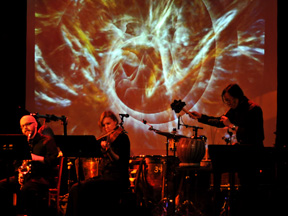
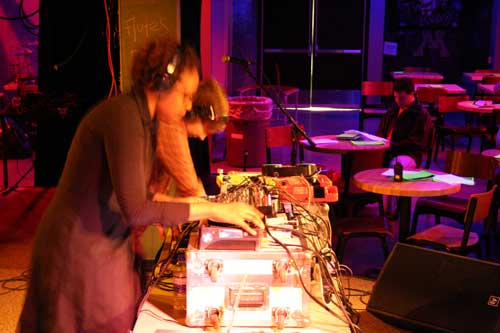
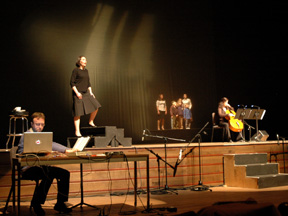
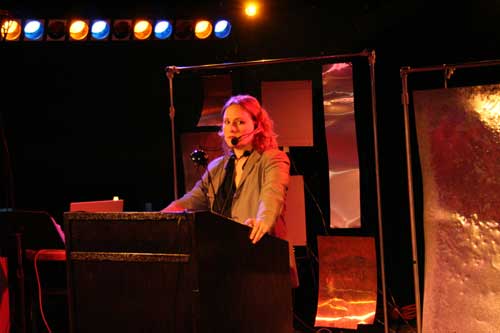
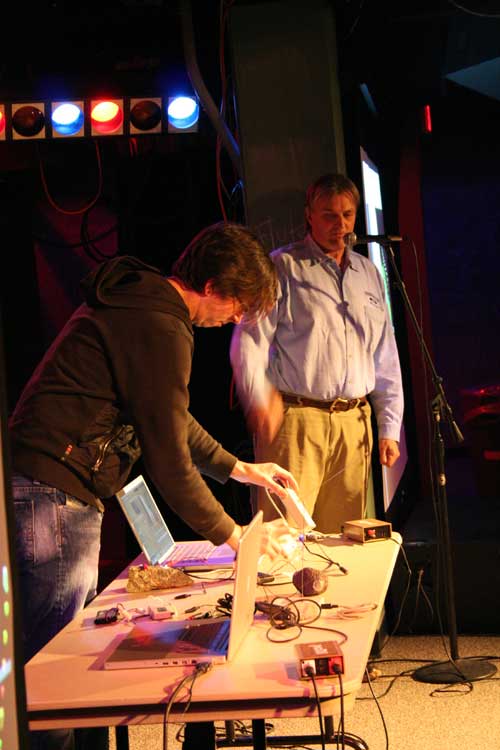

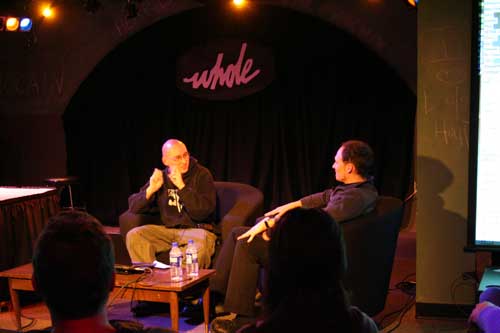
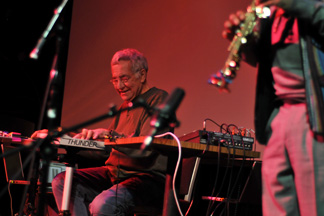
FROM CASEY FARINA‘S ROBOTIC BLIMPS soaring through Ted Mann Concert Hall to music made from metal, rocks, tree rings, and other sources you can (and possibly cant) imagine, SPARK 2008 was another extraordinary chapter in the festivals six-year history of multidisciplinary exploration and expression.
The works at SPARK blurred the lines between performance, composition, and the various other artistic media implicit in its modest subtitle, Electronic Music and Arts. This included the delicately-nuanced virtual puppetry of Mimesis, in which violinist Maja Cerar coaxed her own projected luminescent avatar (courtesy of Liubo Borissov) into floating acrobatics and bizarre transformations. Even more visually stunning was Halflife, a powerful dance work by Olive Bieringa and The BodyCartography Project, which utilized subtle sound design, video, and a battery of acoustic instruments. Crinkly plastic body suits and intricately choreographed, rumbling fiberboard panels coalesced into structures, gestures, and slowly developing scenes of tense calm and silent impact.
Moving fluidly from one artistic medium to another, Omar Daniels Annunciation, performed by the Cantiamo String Quartet, offered a meditation on the varieties of representation used by six Renaissance depictions of Gabriels birth announcement to Mary. Both Daniel and Cantiamo expertly transmuted the paintings subtle differences in shading and texture (projected behind the quartet), and the electronics added poignancy and depth to the works interweaving of common practice harmony and tinges of distortion and dissonance.
In one of the highlights of the festival, Duncan Laurie and collaborator Todd Thiele tapped the tiny electrical current present in rocks, sending a petravoltaic charge through a number of processes to create audio and visual patterns. In this way, the duo attempted to translate the sounds of nature, calling it the first authentic rock music since the Neolithic era.
The festival moved from the microcosmic to the macrocosmic, with work by Iancu Dumitrescu, a leading Romanian composer and one of SPARKs featured artists, who takes an intensely cosmological view of sound and music. The festival included a number of his works, all rooted in guided improvisation and the timbre-focused aesthetic of spectralism; the pieces by Dumitrescu at SPARK included two world premieres, Meteors and Pulsars and Le Silence dOr. Unfortunately, his pieces werent very compelling. Works by Dumitrescu and his colleague Ana-Maria Avram (Other TimeOut of Time, Nouvel Archae, and Meteors and Pulsars) were fraught with long denouements immediately followed by large crashes that quickly ceased to have any effect. For Implosive Eternity, Dumitrescu stood in the back of The Whole running sound while Avram tapped an iBook to play the piece. Its computer music, she coldly intoned. His pieces made audible the risk of music that is reproduced rather than performed.
Something new this year was the Found Sound/Audio Appropriation concert, curated by local bent-funk stars Beatrix*Jar and Whole manager David Hill. One of the programs many standout pieces included David Morneaus Familiar Voices. In the spirit of John Oswalds plunderphonics, the works individual movements included the digital detritus of NPRs Carl Kassel mimicking a cussing Casey Kasem, scissored Cinderella dialogues that upended Disney ideologies of true love, and backwards snippets of Bush quotes (go figure that one out). In a more serious vein, Christopher DeLaurentis Thrill amounted to a recombinant duet between recordings of Shirley Horn and Mary Stallings singing the same song, Youre My Thrill. The result sounded like a pair of dancing shadows, with neither one sure who was leading, that treated the audience to a subtle depiction of the nuances inherent in personal interpretation.
Art and history met whimsy in the work of Paul DeMarinis, another featured artist, whose installations combined scientific theory and experimentation with mechanistic artistry. DeMarinis manipulations reflected and revealed the shadows beyond a machines parts; he often looks to archaic technology for his inspirations. The Edison Effect, for instance, combined the phonograph with laser technology. In one installment of the project, Blue Danube, a laser beam passed through a fish bowl to play a phonograph on the other side. Hapless fish in the bowl stopped the stream of music by blocking the light-sensitive laser.
Another type of projection is integral to the Brooklyn-based Graffiti Research Lab. Youve probably seen things ripped off from GRL, like the LED Aqua Teen Hunger Force ads that shut down Boston. The group strives to provide technological tools and frameworks for artists to manipulate for their own ends. The most vivid display of their work at the festival was Laser Tag, a bike-transported, projectable graffiti unit whose capabilities GRL demonstrated on the walls of the Barbara Barker Center for Dance. The fact that it was projected, though, meant that it could be easily removed. The impermanence of their projections seemed to work against the political stakes of graffiti, which aim to ensure that as many people as possible can see it. James Powderly, co-founder of GRL, doesn’t have the anti-establishment credibility of a street graffiti artist anyhow; he has roots with Honeybee Robotics, a DARPA- and Defense Department-associated robotics company that worked on the Mars rovers, as well as various Homeland Security projects.
Festival-goers were also treated to a preview of Doug Geers new opera, Calling, an opera based around the events of 9/11 and created in collaboration with Wickham Boyle. As we listened, though, it was very apparent that the works beautiful vocal lines were crafted with a more intimate setting in mind than Ted Mann, as the halls acoustics swallowed up the chamber ensemble and the electronic elements were rendered harsh, but small. Another piece engaging current events was David Colls Position, Influence, which featured soprano Carrie Shaw behind a lectern, outfitted with a headset mic as well as contact mikes on her throat. Behind her were three sets of hanging sheet metal of various sizes, twelve pieces in all. Reminiscent of the industrial noise of Einstürzende Neubaten, Shaw declaimed, spat, breathed, and sang through a variety of politically explosive French texts, including statements from De Gaulle, accompanied by a chorus of responses scraped and hummed on the metal sheets.
Simon Reynolds and Richard Devine, two internationally-recognized luminaries of more popular electronic music, were SPARK’s other prominently featured artists. Best known Stateside for his Generation Ecstasy: Into the World of Techno and Rave Culture, Reynolds gave two lectures this year. The first, Just 4 U London: Place and Race in UK Dance Culture, 1990 to 2008, traced the development of various pirate and underground black UK dance cultures, from jungle to grime. His second talk was even better, despite its unnecessarily academic title, “Historia Electronica: The Principles and Praxis of Electronic Dance Culture.” A thirteen-point discussion of electronic dance music and cultures core tenets, Reynolds key points included artists’ embrace (and often abuse) of technology; the importance of the body (quoting Kodwu Eshuns marvelous statement that with this music your body thinks while your mind dances); this music’s ever-present relationship to mind-altering substances; and the particular political associations and movements that come about with the urge to merge in events like raves.
Turning from criticism to composition, electronica virtuoso Richard Devine discussed his own musical development as part of the fantastic Making Music series at The Whole. Devines music combines the hard beat-driven sounds of four-on-the-floor dance music with mutable soundscapes; his is a synthesis of dance-pop culture and academically-driven designs. Devines straddling of both these realms of electronic music was especially evident in his performance of Valez Mix at Ted Mann Concert Hall. Featuring choreography by Annie Hanauer, the dancers changed places horizontally and interacted vertically, so that their motions emulated the undulations of a changing waveform.
The official festival concluded with a long improvisation by Douglas Ewart, Guerino Mazzola, and David Wessel. It was great to have Ewarts AACM lineage represented at SPARK, as the black experimental tradition is usually left out of the more academic spheres of musical experimentalism. Wessel replaced the standard drummer, his fingers moving as deftly as sticks across laptops and a Buchla Thunder MIDI controller, while Ewart took turns on various instruments, including his own invented didgeridoos, soprano sax, bass clarinet, flute, and a shawm, with moments of subtle musical intimacy between he and Mazzola.
Even with all this sophisticated experimentalism and exploration, though, it was clear that SPARK still knows how to party. The four Nightlife concerts held at the Nomad World Pub brought folks from disparate ends of the electronic artistic universe not only into the same room, but even onto the same dance floor. Curated by J.P. Hungelmann, the series featured artists from the Twin Cities and beyond, including the Japanese sound artist Chikashi Miyama and Denmarks Puzzleweasel. At another get-together (complete with free booze and food) NOBOT, with its vocoder harmonies and pulsating textures, even managed to piss off some of the resident artists trying to work during the party. All these after-hours events were packed and proved to be some of the best moments of the entire festival.
But the best part about SPARK is that for exactly $5 you got to see the entire festival (barring the necessary expense of coffee to keep yourself awake). This thriving annual arts spectacle continues to be one of the jewels of new music and media today, both within the Twin Cities and beyond. Were lucky to get so many groundbreaking, internationally-acclaimed performers together every year for this single week, something usually reserved for far-off international festivals. Furthermore, bringing Twin Cities-based artists and these nationally- and globally-recognized artists together continues to inspire the flourishing Twin Cities music and art scene, facilitating new artistic and aesthetic connections that push artists of all stripes here to further explore the boundaries of their media and continually reshape not just how we think about art, but also the very world we live in.
About the writer: Justin Schell is a freelance writer and grad student at the University of Minnesota’s Comparative Studies in Discourse and Society program. He’s working on a dissertation examining the diasporic and immigrant hip-hop of the Twin Cities.